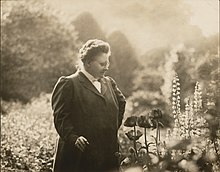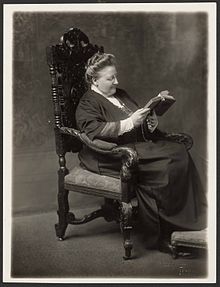Amy Lowell
Amy Lowell | |
|---|---|
 Lowell at Sevenels, circa 1916 | |
| Born | Amy Lawrence Lowell February 9, 1874 Brookline, Massachusetts, U.S. |
| Died | May 12, 1925 (aged 51) Brookline, Massachusetts, U.S. |
| Occupation | Poet |
| Notable awards | Pulitzer Prize for Poetry (1925) |
| Partner | Ada Dwyer Russell (1912–1925)[a] |
Amy Lawrence Lowell (February 9, 1874 – May 12, 1925) was an American poet of the
Life

Amy Lowell was born on February 9, 1874, in
School was a source of considerable despair for the young Amy Lowell. She considered herself to be developing "masculine" and "ugly" features and she was a social outcast. She had a reputation among her classmates for being outspoken and opinionated.[6] At fifteen she wanted to be a photographer, poet, and coach racer.[7]
Lowell never attended college because her family did not consider it proper for a woman to do so. She compensated for this lack with avid reading and near-obsessive book collecting. She lived as a socialite and travelled widely, turning to poetry in 1902 (aged 28) after being inspired by a performance of Eleonora Duse in Europe. After beginning a career as a poet when she was well into her 30s, Lowell became an enthusiastic student and disciple of the art.[8]
Lowell was said to be lesbian, and in 1912 she and actress Ada Dwyer Russell were reputed to be lovers. Russell is reputed to be the subject of Lowell's more erotic works, most notably the love poems contained in 'Two Speak Together', a subsection of Pictures of the Floating World. The two women traveled to England together, where Lowell met Ezra Pound, who at once became a major influence and a major critic of her work. Pound considered Lowell's embrace of Imagism to be a kind of hijacking of the movement. Lowell has been linked romantically to writer Mercedes de Acosta, but the only evidence of any contact between them is a brief correspondence about a planned memorial for Duse.
Lowell was a short but imposing figure who kept her hair in a bun and wore a pince-nez.

Lowell publicly smoked cigars, as newspapers of the day frequently mentioned.[6]: 96 A glandular problem kept her perpetually overweight. Poet Witter Bynner once said, in a comment frequently misattributed to Ezra Pound, that she was a "hippopoetess".[9]: 171 Her admirers defended her, however, even after her death. One rebuttal was written by Heywood Broun in his obituary tribute to Amy. He wrote, "She was upon the surface of things a Lowell, a New Englander and a spinster. But inside everything was molten like the core of the earth ... Given one more gram of emotion, Amy Lowell would have burst into flame and been consumed to cinders."[10]

Lowell died of a
Her first published work appeared in 1910 in
Though she sometimes wrote
Untermeyer writes that "She was not only a disturber but an awakener."[13] In many poems, Lowell dispenses with line breaks, so that the work looks like prose on the page. This technique she labeled "polyphonic prose".[14]
Throughout her working life, Lowell was a promoter of both contemporary and historical poets. Her book Fir-Flower Tablets was a poetical re-working of literal translations of the works of ancient Chinese poets, notably
Lowell published not only her own work, but also that of other writers. According to Untermeyer, she "captured" the Imagist movement from Ezra Pound. Pound threatened to sue her for bringing out her three-volume series Some Imagist Poets, and thereafter derisively called the American Imagists the "Amygist" movement. Pound criticized her as not an imagist, but merely a rich woman who was able to financially assist the publication of imagist poetry. She said that Imagism was weak before she took it up, whereas others said it became weak after Pound's "exile" towards Vorticism.
Lowell wrote at least two poems about libraries—The "Boston Athenaeum"[16] and "The Congressional Library"[17]—during her career. A discussion of libraries also appears in her essay "Poetry, Imagination, and Education".[18]
Relationship with Ada Dwyer Russell

Lowell's partner Ada Dwyer Russell was the subject of many of Lowell's romantic poems,[19] and Lowell wanted to dedicate her books to Russell, but Russell would not allow that, and relented only once for Lowell's biography of John Keats, in which Lowell wrote, "To A.D.R., This, and all my books. A.L."[9]: 62 Examples of these love poems to Russell include the Taxi, Absence, A Lady [20]: xxi In a Garden, Madonna of the Evening Flowers,[21] Opal,[22] and Aubade.[23] Lowell admitted to John Livingston Lowes that Russell was the subject of her series of romantic poems titled "Two Speak Together".[24][25] Lowell's poems about Russell have been called the most explicit and elegant lesbian love poetry during the time between the ancient Sappho and poets of the 1970s.[23] Most of the private correspondence in the form of romantic letters between the two were destroyed by Russell at Lowell's request, leaving much unknown about the details of their life together.[20]: 47
Legacy
In the post-
Additional sources of interest in Lowell today come from the
Lowell's correspondence with her friend Florence Ayscough, a writer and translator of Chinese literature, was compiled and published by Ayscough's husband Professor Harley Farnsworth MacNair in 1945.[27]
Works
- "Fireworks". The Atlantic. Vol. 115. April 1915 – via Google Books.
Books
- A Dome of Many-Coloured Glass. Houghton Mifflin. 1912.
Amy Lowell.
- Sword Blades and Poppy Seed. Macmillan. 1914.
Amy Lowell sword blades.
- Men, Women and Ghosts. Macmillan. 1916.
- Can Grande's Castle. ISBN 0-403-00658-9.
- Pictures of the Floating World. ISBN 0-404-17128-1.
Amy Lowell.
- Legends. Houghton Mifflin. 1921.
- Fir-Flower Tablets. ISBN 0-88355-058-X.
- Lowell, Amy (1922). A Critical Fable. Read Books. ISBN 9781408601471.
- What's O'Clock. Houghton Mifflin. 1925.
- East Wind. Houghton Mifflin. 1926.
Amy Lowell.
- Ballads for Sale. Houghton Mifflin. 1927.
- Bradshaw, Melissa; Munich, Adrienne, eds. (2002). Selected Poems of Amy Lowell. New Brunswick, New Jersey: ISBN 978-0-8135-3128-1 – via Google Books.
- The Complete Poetical Works of Amy Lowell. Boston, Massachusetts: Houghton Mifflin. 1955 – via Google Books.
- Damon, S. Foster (1935). Amy Lowell: A Chronicle, With Extracts from her Correspondence. Boston, Massachusetts: Houghton Mifflin.
- The Touch of You Amy Lowell's Poems of Love and Beauty selected by Peter Seymour. ISBN 0875292887 – via Internet Archive.
Criticism
- Amy Lowell (1925). John Keats. Houghton Mifflin.
Anthology
- Some imagist poets. Vol. 3. ISBN 1-4191-4804-4.
Choral settings of poetry
- To a Friend, by Giselle Wyers. Santa Barbara Music Publishing, Inc.
- Sea Shell, by Vicente Chavarria. Santa Barbara Music Publishing, Inc.
- This Perfect Beauty, by Jenni Brandon. Santa Barbara Music Publishing, Inc.
- A Winter Ride, by Misty L. Dupuis. Earth Cadence Publishing.
- The Giver of Stars, by Jenni Brandon. Jenni Brandon Music.
- A Dome of Many-Coloured Glass, by Dominick DiOrio. Hal Leonard.
- A Sprig of Rosemary, by Jeffrey Van. Hal Leonard.
- Absence, by Dominick DiOrio. G. Schirmer.
- At Night, by Jenni Brandon. Jenni Brandon Music.
- You Are the Music, by Victor C. Johnson. Chorister's Guild.
- The Giver of Stars, by Joan Szymko. Independent Music Publishers Cooperative.
- You Are the Music, by Joan Szymko. Independent Music Publishers Cooperative.
See also
Notes
References
- ISBN 0813531284.
- ISBN 978-0-8070-7949-2
- ISBN 978-1848933866.
- ^ Lowell, Delmar R. (1899). The Historic Genealogy of the Lowells of America from 1639 to 1899. Rutland, Vermont: Tuttle Publishing. p. 283 – via Google Books.
- ^ Chosön, the Land of the Morning Calm; a Sketch of Korea. Ticknor and Company. 1888. Retrieved April 30, 2013 – via Google Books.
- ^ a b Gregory, Horace (1958). Amy Lowell: Portrait of the Poet in her Own Time. Freeport, New York: Books for Libraries Press – via Google Books.
- .
- ^ "Amy Lowell". Poetry Foundation. March 10, 2021. Retrieved March 10, 2021.
- ^ ISBN 0813533562 – via Google Books.
- ISBN 978-81-7211-149-6 – via Google Books.
- ISBN 978-0-7864-7992-4 – via Google Books.
- Houghton Mifflin. p. 257 – via Google Books.
- ISBN 978-0-87023-720-1 – via Google Books.
- ISBN 978-0-8130-1591-0 – via Internet Archive.
- Houghton Mifflin. p. 152 – via Internet Archive.
- Houghton Mifflin. p. 115 – via Internet Archive.
- ^ Lowell, Amy. "The Congressional Library". Library of Congress.
- .
- ISBN 0231125119 – via Google Books.
- ^ .
- ^ Hamer, Diane (December 30, 2013). "The Love Songs of Amy Lowell". The Gay & Lesbian Review Worldwide. 21 (1): 48.
- University of Illinois.
- ^ a b Karami, Siham (July–August 2016). "In the Manner of Amy Lowell" (PDF). The Gay & Lesbian Review Worldwide. 23 (4): 39.
- ^ Faderman, Lillian. "Amy Lowell (1874–1925)". Georgetown University.
- ^ Hamer, Diane Ellen (July 1, 2004). "Amy Lowell wasn't writing about flowers". The Gay & Lesbian Review Worldwide. 11 (4) – via Gale.
- ISBN 978-3-8258-8616-5.
- ^ Farnsworth MacNair, Harley, ed. (1946). Florence Ayscough and Amy Lowell: Correspondence of a Friendship. University of Chicago Press – via Google Books.
External links
- Works by Amy Lowell at Project Gutenberg
- Works by or about Amy Lowell at Internet Archive
- Works by Amy Lowell at LibriVox (public domain audiobooks)

- Poems by Amy Lowell and biography at Poetry Foundation
- "How Does the New Poetry Differ from the Old?; Amy Lowell Laments the Lack of Authoritative Criticism in America – Says No One Should Make a Living by Writing". The New York Times. March 26, 1916.
